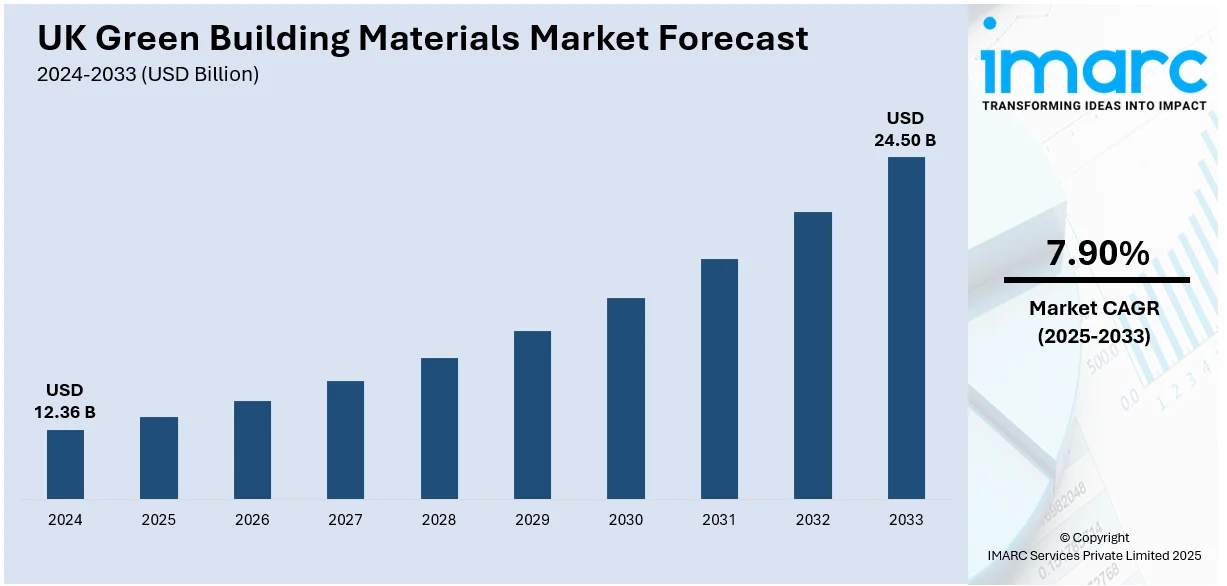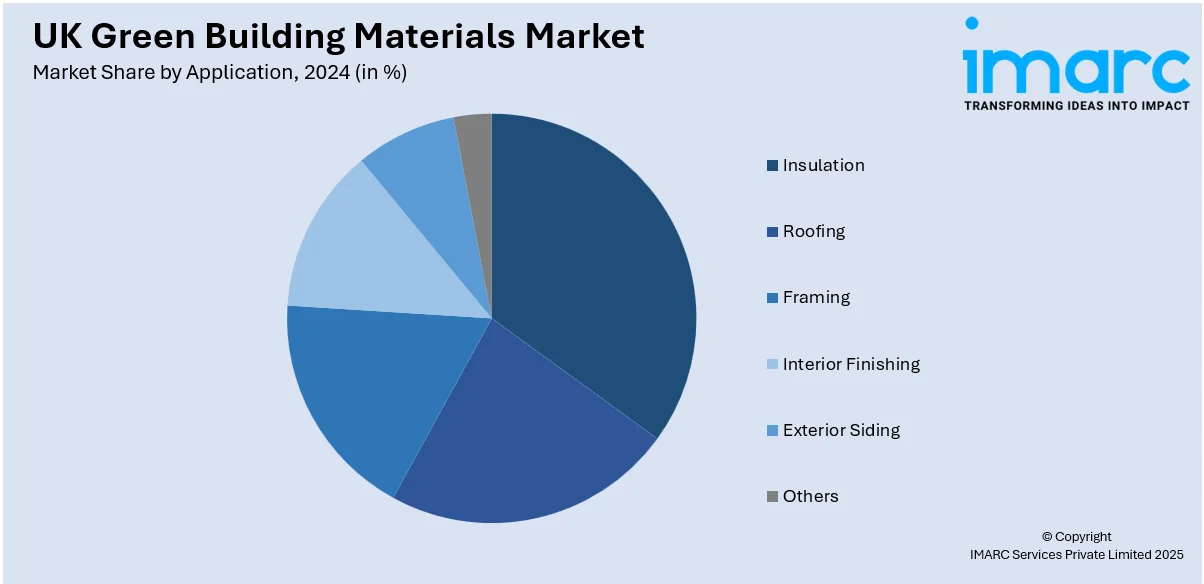
UK Green Building Materials Market Size, Share, Trends and Forecast by Application and Region, 2025-2033
UK Green Building Materials Market Overview:
The UK green building materials market size reached USD 12.36 Billion in 2024. Looking forward, IMARC Group expects the market to reach USD 24.50 Billion by 2033, exhibiting a growth rate (CAGR) of 7.90% during 2025-2033. Increased sustainability requirements, greater awareness of eco-friendly construction, government incentives for green projects, energy efficiency standards, and a growing desire for healthier, non-toxic building environments are the main factors fueling the UK green building materials market growth.
|
Report Attribute
|
Key Statistics
|
|---|---|
|
Base Year
|
2024
|
|
Forecast Years
|
2025-2033
|
|
Historical Years
|
2019-2024
|
| Market Size in 2024 | USD 12.36 Billion |
| Market Forecast in 2033 | USD 24.50 Billion |
| Market Growth Rate (2025-2033) | 7.90% |
UK Green Building Materials Market Trends:
Government Regulations and Sustainability Initiatives
Strong focus by the government of the UK on lowering the carbon footprint and sustainability is an important force that drives the UK green building materials market share. Frameworks like net-zero by 2050 under the UK Government have compelled the construction sector to minimize its influence on the environment. The introduction of the Building Regulations Part L (energy efficiency) and the future homes standard compels construction firms to embrace sustainable materials that satisfy energy performance criteria. Also, incentives such as grants, tax reliefs, and funds for environmentally friendly building schemes motivate the utilization of green materials. For example, the green homes grant scheme is just such a scheme which encourages house owners to install energy-efficient upgrades through the use of sustainable materials. Such regulatory systems not only encourage environmental sustainability but also foster the development of the market by inducing a demand for new innovative greener materials.

Increasing Consumer Demand for Eco-Friendly Construction
Consumer tastes have shifted significantly toward environmentally friendly construction approaches. Homebuyers, investors, and renters are increasingly valuing sustainability, energy efficiency, and health-related advantages when making property purchases. The demand for buildings that provide better living conditions with little exposure to chemicals and pollution is increasing. Green construction products, such as non-toxic paints, sustainable lumber, and recycled materials, help to enhance indoor air quality while reducing environmental effects. This consumer demand is being driven by increased knowledge of climate change, a desire to decrease personal carbon footprints, and the financial advantages of energy-efficient buildings, such as lower electricity costs. As a result, construction businesses are under pressure to include green materials in their projects to fulfill customer expectations and maintain the positive UK green building materials market outlook and competitiveness.
Advancements in Green Building Technologies
Technological breakthroughs are playing a critical role in boosting the use of green construction materials. Building Information Modelling (BIM), 3D printing, and prefabrication procedures are examples of innovative technology that enable more efficient and sustainable building processes. BIM, for example, enables architects and builders to design structures that maximize material efficiency and waste reduction, so boosting sustainability. The development of novel materials, such as low-carbon concrete, recovered wood composites, and renewable resource insulation, has further broadened the market's selection of green building materials. These technologies and materials improve the durability, energy efficiency, and environmental performance of buildings, making them more desirable to both developers and users.
UK Green Building Materials Market Segmentation:
IMARC Group provides an analysis of the key trends in each segment of the market, along with forecasts at the regional level for 2025-2033. Our report has categorized the market based on application.
Application Insights:

- Insulation
- Roofing
- Framing
- Interior Finishing
- Exterior Siding
- Others
A detailed breakup and analysis of the market based on the application have also been provided in the report. This includes insulation, roofing, framing, interior finishing, exterior siding, and others.
Regional Insights:
- London
- South East
- North West
- East of England
- South West
- Scotland
- West Midlands
- Yorkshire and The Humber
- East Midlands
- Others
The report has also provided a comprehensive analysis of all the major regional markets, which include London, South East, North West, East of England, South West, Scotland, West Midlands, Yorkshire and The Humber, East Midlands, and others.
Competitive Landscape:
The market research report has also provided a comprehensive analysis of the competitive landscape. Competitive analysis such as market structure, key player positioning, top winning strategies, competitive dashboard, and company evaluation quadrant has been covered in the report. Also, detailed profiles of all major companies have been provided.
UK Green Building Materials Market News:
- In July 2023, The Sweden Green construction Council (SGBC) and the UK Green Building Council (UKGBC) joined forces with Helvar, a global pioneer in intelligent lighting solutions, to encourage the adoption of sustainable construction practices. By combining intelligence with data-driven analytics, Helvar helps building managers and owners create future-proof workplaces that reduce expenses and environmental impact.
UK Green Building Materials Market Report Coverage:
| Report Features | Details |
|---|---|
| Base Year of the Analysis | 2024 |
| Historical Period | 2019-2024 |
| Forecast Period | 2025-2033 |
| Units | Billion USD |
| Scope of the Report | Exploration of Historical Trends and Market Outlook, Industry Catalysts and Challenges, Segment-Wise Historical and Future Market Assessment:
|
| Applications Covered | Insulation, Roofing, Framing, Interior Finishing, Exterior Siding, Others |
| Regions Covered | London, South East, North West, East of England, South West, Scotland, West Midlands, Yorkshire and The Humber, East Midlands, and Others |
| Customization Scope | 10% Free Customization |
| Post-Sale Analyst Support | 10-12 Weeks |
| Delivery Format | PDF and Excel through Email (We can also provide the editable version of the report in PPT/Word format on special request) |
Key Questions Answered in This Report:
- How has the UK green building materials market performed so far and how will it perform in the coming years?
- What is the breakup of the UK green building materials market on the basis of application?
- What is the breakup of the UK green building materials market on the basis of region?
- What are the various stages in the value chain of the UK green building materials market?
- What are the key driving factors and challenges in the UK green building materials?
- What is the structure of the UK green building materials market and who are the key players?
- What is the degree of competition in the UK green building materials market?
Key Benefits for Stakeholders:
- IMARC’s industry report offers a comprehensive quantitative analysis of various market segments, historical and current market trends, market forecasts, and dynamics of the UK green building materials market from 2019-2033.
- The research report provides the latest information on the market drivers, challenges, and opportunities in the UK green building materials market.
- Porter's five forces analysis assist stakeholders in assessing the impact of new entrants, competitive rivalry, supplier power, buyer power, and the threat of substitution. It helps stakeholders to analyze the level of competition within the UK green building materials industry and its attractiveness.
- Competitive landscape allows stakeholders to understand their competitive environment and provides an insight into the current positions of key players in the market.
Need more help?
- Speak to our experienced analysts for insights on the current market scenarios.
- Include additional segments and countries to customize the report as per your requirement.
- Gain an unparalleled competitive advantage in your domain by understanding how to utilize the report and positively impacting your operations and revenue.
- For further assistance, please connect with our analysts.
 Request Customization
Request Customization
 Speak to an Analyst
Speak to an Analyst
 Request Brochure
Request Brochure
 Inquire Before Buying
Inquire Before Buying




.webp)




.webp)












